Tripod Brixton,
Lambeth Town Hall,
1 Brixton Hill, London,
SW2 1RW
Hours: Monday to Friday, 8am – 7pm
Phone: 020 7580 7333
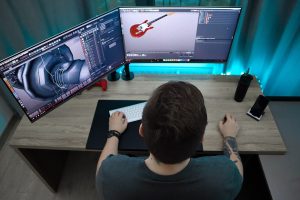
A career in Animation means you have the ability to bring art to life, whether it be through animations, special effects, and other visual images. You will work at the intersection of creativity and technology, through the use of digital tools to bring designs to life for advertisements, films, cartoons, online media and more!
We’re diving into the world of animation to answer all your questions about this design career, so keep reading to find out what it’s really like to turn your passion for art into a career as an animator.
Alternatively, if you’re looking to hire an Animator in your company then please call us on 020 7580 7333 or email us on info@yellowcat.london.
What is Animation?
Animation is the method of manipulating figures so that they appear as if they are moving images. This simulation of movement is achieved by taking photos or drawings of the subject successively. Animation takes information about our eyes and how we retain images into consideration. The length of time an image is retained is one tenth of a second. So, animators put multiple images in fast succession so that the brain blends all of them into perceived movement.
There are so many directions within animation alone, a lot of animators decide to choose one industry and adapt their skills set to it. For example, working in film you might decide to focus on character animation or flame art whereas in gaming you would focus on real-time rendering.
With this in mind, here is a snapshot of the most popular types of animation.
Types, Styles & Principles
Back in 1906, “Humorous Phases of Funny Faces” was the first animated film ever to be printed on standard motion picture film – far before the likes of any fancy software’s like Maya, Houdini or 3DS max.
Executed using the traditional animation technique this short film laid the foundations for future animation and then over time animators across the industry devised a set of procedures and principles that continue to govern the industry standard.
Traditional animation is when pictures are drawn and photographed frame by frame with each drawing slightly changing to create the illusion of movement.
Stop motion animation is when real life objects (i.e. models) are physically manipulated frame by frame to create the illusion of movement.
Computer animation as the name suggests is when you use computers and software to create either 2D or 3D animation…
2D animation being the manipulation of 2D vector graphics which uses the techniques of traditional animation, onion skinning, interpolated morphing and rotoscoping.
3D animation on the other hand focuses on manipulating 3D rigged models (created by modelling artists) creating the illusion of movement.
Other principles worth researching that are worth researching if you’re interested in a career in animation are the following:
Squash and stretch (also known as S&S) is in many ways seen as the most important of the 12 principles. It works on the basis that of applying contrasting change to a shape, it goes from a squash pose to a stretch pose. This is a popular technique and can be recognised easily within feature animation.

Anticipation which is a technique that prepares the audience for an action as demonstrated in the picture below. It can also be used in less physical situations for example closing the laptop screen to signal someone coming in.
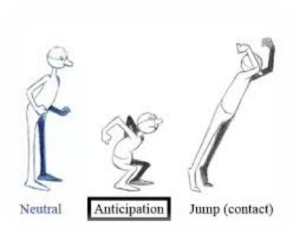
Staging, this principles purpose is to direct the audience’s attention to import parts of the scene/storyline. This can be done through a number of creative ways i.e. lighting, placement of the camera, shadows etc. As long creates an unmistakable direction that plays a party in the scene/story – its staging.

Straight ahead action and pose to pose are both approaches to the drawing process. Pose to pose being when you draw the key frames of first then fill in the gaps whereas straight ahead action when you draw animation frame by frame beginning to end.
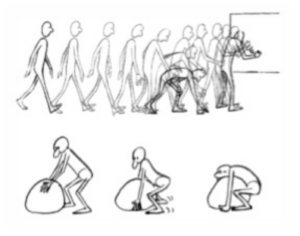
Follow through and overlapping action are techniques that help render movement more realistically through changing the timing of movement particular parts of each frame, i.e. with a running squirrel the legs move faster than the body or when their tail blows in the wind.

Slow in and slow out is the part of animation process got its name from the fact it takes longer to animate the start and end of each action. This is because with moving g objects more happens at the start/end which the animator has to capture.
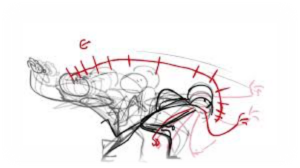
Arcs is the rule that for animation to look real actions must follow the most natural trajectory. For example, when you bounce a bouncy ball against a wall it will follow a sequence of natural arches before it bounces back to you.
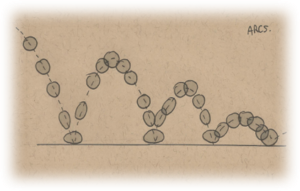
Secondary action is a guideline that says adding a secondary action where possible to a main action can add realism, character and emotion to your animation.
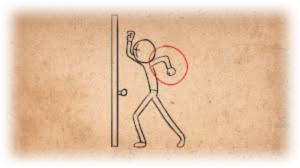
Timing is simply the number of frames in a given action, correct timing can create a realistic flow and illusion of gravity. Editing the timing of an object relates heavily with the emotion/mood you are trying to create.
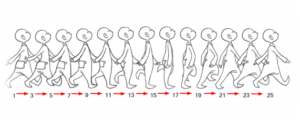
Exaggeration is an effect that’s another favourite in feature animation. As the name suggests exaggeration takes ordinary emotions/actions and amplifies them in a way to highlights characteristics of the subjects in an engaging way.

Solid drawing is the principle of giving a forms volume and weight to create a three-dimensional model. Modern-day computer animators draw less because of the facilities computers give them, but just u8ndertanding this concept benefits them greatly when modelling.

Appeal is the type of charisma a character hold. Whether they be a good, a baddy, or even the overly innocent one, it’s what makes the character interesting and likable (or not!).

It’s a lot to take in – we know! But this venture into animation should help you work your way around the sector.
What is a typical day to day of an animator?
You will generally find animators working on:
How can I become an animator?
Don’t worry if some of those technical skills above sound intimidating! A high-quality education can teach you the skills you need to make it in animation design. It’s worth noting that most employers are looking for candidates with a bachelor’s degree in animation or a related design field.
Having a solid portfolio to showcase your skills is also important in this visual field. Most degree programs will offer plenty of opportunities to sharpen your skills and build up a body of work to show potential employers.
However, it isn’t just about what qualifications you have, but who you are as a creative professional. Being an animator, you need excellent observations skills in order to replicate body language and movement of things. Studying how people walk, run, sit, stand, frown, smile etc. helps you create more realistic shots in production.
It can actually be quite common for animators to have a passion for acting, or come from a stage school/university background as they are able transition this knowledge into animation.
If you’d like help breaking into the industry, contact us here at Yellow Cat for the latest job openings, advice on becoming a freelancer and CV support.
How do I book an Animator?
If you would like to enhance your project, here at Yellow Cat we have a wide network of talented Animators to suit all client needs. We have talents looking for permanent Animator opportunities as well as a rich talent pool for clients to hire freelance Animators from.
Tripod Brixton,
Lambeth Town Hall,
1 Brixton Hill, London,
SW2 1RW
Hours: Mon to Fri, 8am – 7pm
Phone: 020 7580 7333
Tripod Brixton,
Lambeth Town Hall,
1 Brixton Hill, London,
SW2 1RW
Hours: Monday to Friday, 8am – 7pm
Phone: 020 7580 7333